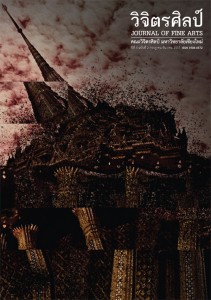เจดีย์ช้างล้อมและเจดีย์สิงห์ล้อมใน กรุงศรีอยุธยา
Main Article Content
บทคัดย่อ
ในช่วงเวลาที่ผ่านมาเรื่องราวของเจดีย์ช้างล้อมและเจดีย์สิงห์ล้อมที่ปรากฏอยู่ในกรุงศรีอยุธยายังมีคำอธิบายไม่มากนัก บทความนี้เป็นส่วนหนึ่งของงานวิจัยที่ผู้เขียนได้ทำการศึกษาเรื่องราวพระพุทธศาสนาลังกาวงศ์กับเจดีย์ช้างล้อมในประเทศไทย ซึ่งได้ตัดตอนมานำเสนอเฉพาะเรื่องราวของเจดีย์ช้างล้อมและเจดีย์สิงห์ล้อม เพื่ออธิบายถึงการเกิดขึ้นของเจดีย์ช้างล้อมและเจดีย์สิงห์ล้อมที่มีความสัมพันธ์เกี่ยวข้องกับประวัติศาสตร์บ้านเมือง ประวัติพระพุทธศาสนา และศิลปะสถาปัตยกรรมในกรุงศรีอยุธยา
ผลของการศึกษาพบว่าในกรุงศรีอยุธยามีเจดีย์ช้างล้อมจำนวน 3 แห่ง คือพระเจดีย์ประธานวัดมเหยงคณ์ พระเจดีย์ประธานวัดช้าง และเจดีย์ทรงระฆังช้างล้อมวัดหัสดาวาส และเจดีย์สิงห์ล้อมจำนวน 2 แห่ง คือ เจดีย์ประธานวัดแม่นางปลื้ม และเจดีย์ประธานวัดธรรมิกราช การปรากฏขึ้นของเจดีย์ช้างล้อมและเจดีย์สิงห์ล้อมจะอยู่ในช่วงพุทธศตวรรษที่ 20 ซึ่งเป็นระยะเวลาที่พระพุทธศาสนาลังกาวงศ์เผยแผ่เข้ามา ทำให้เกิดการแข่งขันกันระหว่างพระพุทธศาสนาสายพื้นเมืองเดิมที่สืบทอดมาจากเมืองลพบุรีหรืออาณาจักรเขมรอันรุ่งเรืองกับพระพุทธศาสนาลังกาวงศ์สายสีหลและสายรามัญ การสร้างเจดีย์ช้างล้อมและเจดีย์สิงห์ล้อมขึ้นนั้นเพื่อให้เป็นสัญลักษณ์ประกาศถึงความเป็นพระพุทธศาสนาบริสุทธิ์ และเพื่อสร้างความชอบธรรมให้ได้รับการสนับสนุนและยอมรับนับถือ
Chang Lorm Chedis and Singha Lorm Chedis in Ayutthaya
From the past up to the present time, Chang Lorm Chedis (Elephant- Surrounded Pagodas) and Singha Lorm Chedis (Lion- Surrounded Pagodas), which appeared in Ayutthaya Period, have not been much described. This article is an excerpt from the research project of the study on Theravada Buddhism and Chang Lorm Chedis in Thailand. This excerpt focuses on Chang Lorm Chedi and Singha Lorm Chedi with the aim of describing the founding of the two chedis, which is relevant to the histories of the kingdom, Buddhism and architectural arts in Ayutthaya.
The findings from the study reveal that, in Ayutthaya, there are three Chang Lorm Chedis, i.e., the principle pagoda of Mahaeyong Temple, the principle pagoda of Chang Temple and the bell-shaped pagoda surrounded with elephant statues at Hatsadawat Temple; and two Singha Lorm Chedis, i.e., the principle pagoda of Mae Nang Pluem Temple and the principle pagoda of Dhammikarat Temple. Chang Lorm and Singha Lorm Chedis were founded during 20th Buddhist century which is the period in which Ceylonese Theravada Buddhism was disseminated in Ayutthaya. This created competition between the Buddhism from Lopburi or Khmer Kingdom, which had been prosperous in the region before, and Theravada Buddhism from Singhala (Sri Lanka and Mon. Chang Lorm and Singha Lorm Chedis were built in order to symbolize that the pagodas represented the purity of Buddhism in order make Theravada Buddhism righteous and accepted by local people.


